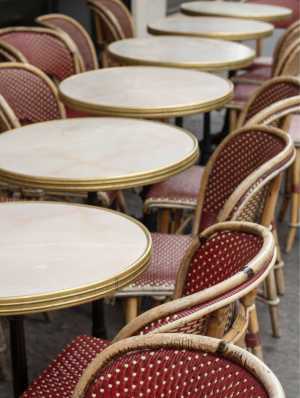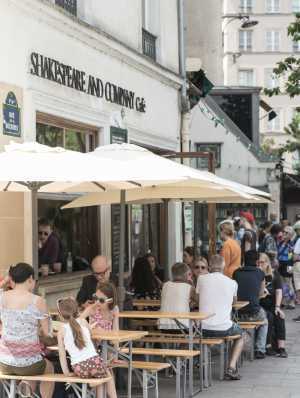Paris may always be a good idea, but ordering “un café” isn’t. Of course, the bitter truth about the French roast is outmeasured by the fact that visiting a café, and loafing at length on its sidewalk terrace, is an excellent diversion. From many a rattan chair, food critics have decried the state of le café français, labelling it at turns vile, undrinkable, donkey piss and jus de chaussette (literally: sock juice). “If you’re a coffee lover and you come to Paris, there’s always tea,” quips Paris-based cookbook author David Lebovitz.
Ten years ago, the well-known pastry chef and blogger would have told you the only decent espresso to be found in France was Italian. But now even some of the harshest critics, Lebovitz included, admit that a coffee revolution is underway in Paris, marshalled not by Italians, but mainly Australians and the French – many of whom have spent time in the Land Down Under.
An important forerunner to the Australian invasion is La Caféothèque, opened in 2005 by Gloria Montenegro, former Guatemalan ambassador to France. It should seem appropriate that certain seats in her boutique, positioned on the right bank of the Seine in the fourth arrondissement, have Notre Dame in view, since the shop has earned a reputation as a mecca for coffee devotees.
Part salon, part brûlerie (roastery) and part academy, Montenegro’s bold venture brought more than quality beans to the city; it laid the framework for a new school of coffee connoisseurs. Whether there for an expresso (the French spell it with an x), or a fresh blend to take home, all visitors leave La Caféothèque with a lesson in geography.
In the main salon, a wall-length cabinet maps out the world’s coffee producers – from Sri Lanka, to Madagascar, to Peru – across 70 vintage drawers, each one containing a cache of beans ready for roasting. For those wanting to earn a cred in coffeology, the academy’s two-hour initiation course takes students on a journey around the coffee world, exploring five regions and five unique extraction methods.
Such variety was a novelty to Parisians when La Caféothèque opened in the early aughts. Before the deregulation of coffee in the 1950s, France’s palate was not particularly well travelled. Tariffs imposed in the late seventeenth century favoured imports from French colonies in West Africa and the Caribbean, which predominantly produced robusta.
Ten years ago, the only decent espresso to be found in France was Italian
Lower in cost and quality, beans of the robusta variety are thinner in flavour and more harsh-tasting than the refined arabica bean, which carries twice as many chromosomes. Rarely used on its own, robusta is often blended with arabica as a cost-saving measure. This is why coffeemakers brag when they offer 100 per cent arabica, and blenders that don’t, such as France’s leading brand Cafés Richard, will cop only to containing “hints of robusta,” or alternately, “a touch of the highest quality robusta offers.”
Most coffee you’ll find at a traditional café or brasserie will be rich in robusta, thanks in part to the so-called Auvergnat mafia, which has held a hundred-year monopoly on these establishments by supplying everything from espresso machines to mortgage payments in exchange for the sole use of certain brands. “That’s a large part of the reason that you haven’t seen large brasseries make a shift,” says Anna Brones, author of Paris Coffee Revolution. “It’s really difficult to do.”
In the years following the founding of La Caféothèque, brûleries began to crop up across the capital. Now with five locations in Paris, Terres de Café sources coffee from farms and local collectives in Africa and Latin America and roasts only in-house. L’Arbre à Café set up shop on rue de Nil, a street frequented by foodies, specializing in single-origin roasts. Notable clientele include renowned pastry chef Pierre Hermé, who fell in love with grand cru like the Bourbon Pointu from Reunion Island (one of the oldest varieties of arabica in the world). Coutume, Café Lomi and KB Caféshop were among the first to import Aussie-inspired roasting techniques to the city.
By presenting coffee as a produit du terroir, a designation typically reserved for wine and cheese, Parisian roasters opened the door to a more nuanced appreciation of coffee’s complexities. Terroir, the notion that taste is intimately tied to place of origin, environment and cultivation, has long been the lens through which a wine’s character, personality and quality are evaluated. “When you explain specialty coffee to a French client, especially its similarity to wine in how it’s a product of the earth and that’s why different coffees have different tastes, they listen attentively and understand,” says Channa Galhenage, owner of Loustic.
A well-roasted coffee holds more than 800 aromatic compounds
The analogy provides a means to convey coffee’s aromatic potential, which is in fact, much more complex than wine’s. At most, the finest wines contain up to 250 aromatic compounds. A well-roasted coffee holds more than 800. Many restaurants sell themselves just as much with a strong coffee programme as they do a stellar wine list.
“When it came to opening my restaurant, I knew I wanted to do something where all of the ingredients, from the beginning to the end of the experience were special,” says Justin Kent, who opened Zia, a café near the Eiffel Tower. Having worked in the kitchens of three-Michelin-starred Arpège, Verjus and L’Agape Substance, Kent’s ardor for high quality ingredients naturally extended to coffee beans. For a service that would complement this market-fresh, Mexican-inspired menu, he selected Coutume as the restaurant’s principal roaster. “We generally try and stick with coffee that’s been roasted in France,” he explains.
Zia is the first and only restaurant in Paris to put nitro cold brew on its menu. After cooling for 20 hours, coffee is poured from a tap and infused with nitrogen so that it pours thick and silky like Guinness on draught. If good ingredients deserve good coffee, as Kent proves at Zia, then the same has proven true in reverse. “People come to a coffee shop for the laidback vibe and the chilled experience,” but they also want “good honest food and good quality coffee,” says Guy Griffin, the British ex-pat who runs Café Oberkampf and Café Mericourt.
While branded as cafés, Griffin’s restaurants are as well known for sit-down meals as they are for specialty coffee, especially his shakshuka eggs, which may very well be the most photographed meal in all of Paris. “With growing competition in Paris and France, you cannot have one without the other,” Griffin says. That may be what led Ten Belles, a treasured Canal St. Martin café, to open Ten Belles Bread two years ago.
The leavened incarnation of the original café now accompanies its Belleville Brûlerie-sourced brews with courses of breakfast, lunch and brunch on the weekends. With a bakery in back, pastries and baked goods are made available to customers and supplied to nearby restaurants – including Griffin’s. Of course for Australians, a good cup of coffee is best served with a hearty brunch – a meal that was once as foreign to Parisians as specialty brews.
The French have come to consider brunch a mid-afternoon affair
After time spent in Australia and Canada, the French duo behind Holybelly were among the first to introduce Aussie-style brunching to Parisians, serving warm plates and measured espresso with signature wit. Pop references like their Flat “Walter” White and their not-so-secret Wi-Fi password (psst, it’s “Macaulay Culkin”) have lured in many a visitor, including Macaulay Culkin himself. Around the corner from Sacré Coeur in Montmartre, Hardware Société puts a Melbournian twist on le brunch with sweet and savory mash-ups of French ingredients and Aussie classics.
Meanwhile at its locations in Palais Royal and St. Germain-des-Prés, Claus manages the unusual feat of serving a brunchy breakfast all day. According to Griffin, the French have come to consider brunch a mid-afternoon affair, waiting until between 1 and 3 p.m. to head out to a restaurant. By that time the crowd usually “arrives pretty hangry,” he says. Since early morning clientele is far less common at café-restos, most don’t open until 9 a.m. and they’ll typically close before 5 o’clock.
Riding the crest of its third-wave, the specialty coffee scene in Paris now has something for everyone. Shakespeare & Company’s café beside a bookstore is ideal for bibliophiles in need of a pause café. Café Kitsuné, created by the eponymous French electronic music label, serves upbeat java to go (and sur place), perfect for a promenade around Palais Royal. Cyclists have Le Peloton and Steel Cyclewear and Coffee Shop to park their bikes and refuel.
Green coffee fiends can escape to La Recyclerie, a repurposed use for an abandoned train station-turned-sustainable urban farm and co-working space. Meanwhile La Fontaine de Belleville’s belle époque façade and overflowing sidewalk terrace provides a vintage backdrop for people-watching all day. Teeming with a young and vibrant crowd, reminiscent of a bygone sort of café society, the bar reminds us why the French should be forgiven for burning beans over the years. After all, in the words of French author Victor Hugo: “To err is human. To loaf is Parisian.




